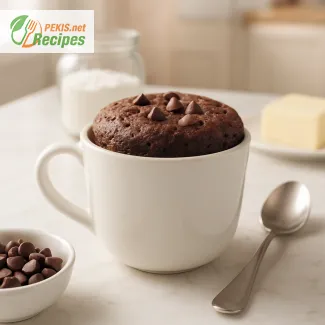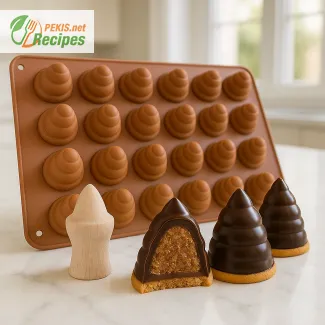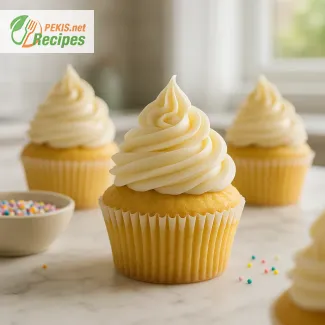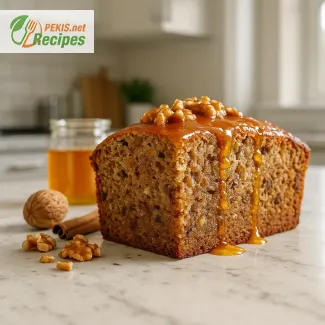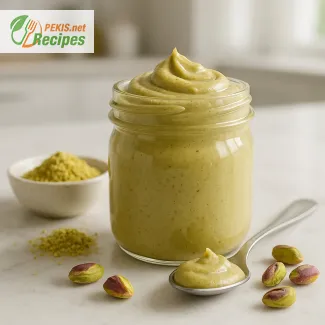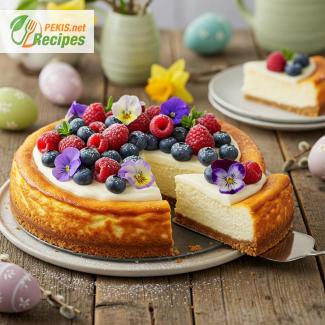
A Heavenly Easter Dessert: Silky Cheesecake for Your Holiday Table
Discover the elegance of a rich, creamy Easter cheesecake that’s as beautiful as it is delicious
When spring awakens nature and the scent of blooming flowers begins to fill the air, it’s also time to breathe new life into our kitchens. Easter is more than just a holiday—it's a celebration of rebirth, renewal, and togetherness. And what better way to honor this joyful occasion than by preparing a show-stopping dessert that blends tradition with indulgence? Enter the Easter cheesecake—a decadent treat that brings smooth, tangy creaminess and subtle sweetness to the forefront of your holiday feast.
Cheesecake has long been a symbol of celebration, dating back to ancient Greece. Over time, it has evolved, transformed by different cultures into a dessert loved worldwide. During Easter, it takes on a particularly meaningful role, especially when paired with fresh spring ingredients like lemon zest, seasonal berries, or a touch of vanilla. This dessert doesn’t just end a meal—it crowns it.
Unlike heavier holiday desserts, the Easter cheesecake feels light and refined. Its creamy filling rests on a buttery, slightly crisp base that provides a satisfying contrast. When topped with delicate fruit compotes, pastel-colored decorations, or even floral designs, it becomes a centerpiece worthy of admiration. And the flavor? Pure bliss. It’s a delicate balance of silkiness, richness, and a slight tang, complemented by just the right level of sweetness to make it unforgettable.
For families and food lovers alike, baking an Easter cheesecake can become a cherished tradition. From selecting the best quality cream cheese to choosing the ideal crust—be it graham cracker, biscuit, or almond—each element plays a part in the final masterpiece. Whether you're an experienced baker or just exploring desserts, this cheesecake offers both ease and elegance, making it accessible yet luxurious.
One of the joys of this dessert lies in its versatility. Want to add lemon curd? Go for it. Fancy a swirl of raspberry? It works beautifully. Prefer a touch of spice like cinnamon or cardamom? They bring depth and warmth. It’s this customizability that makes cheesecake the perfect Easter canvas—ready to adapt to any personal taste or regional tradition.
If you're hosting an Easter brunch, a mid-afternoon gathering, or a formal dinner, this cheesecake recipe will elevate your menu. Its visual appeal—especially when decorated with seasonal garnishes like edible flowers, white chocolate shavings, or pastel drizzles—adds a touch of festive charm. And let’s not forget the joyful surprise it brings to every guest who takes that first silky bite.
Beyond its taste and texture, the emotional connection to cheesecake is powerful. It's a dessert that brings people together, encouraging conversation, laughter, and those precious moments we hold dear. During Easter, when families reunite and traditions are passed down, presenting a homemade cheesecake at the center of the table becomes an act of love.
To prepare the perfect Easter cheesecake, it’s important to consider baking techniques, cooling methods, and presentation. A well-baked cheesecake should have a smooth, crack-free top and a firm but creamy interior. Achieving this takes care, but the reward is immense. Some opt for a water bath during baking for extra moisture, while others prefer a slow, gentle cool-down to preserve its structure and taste.
Easter also symbolizes lightness, which is reflected in modern takes on cheesecake. Many bakers now opt for no-bake versions, lighter cream cheese blends, or even vegan and gluten-free alternatives to accommodate different dietary needs. But at its heart, the essence remains the same: a silky dessert that brings joy.
So whether you're preparing your very first Easter cheesecake or perfecting your long-standing family recipe, let this dessert shine as the star of your spring celebration. It’s more than a sweet treat—it’s an experience, a memory in the making, and a timeless tribute to the beauty of Easter.
Coming up next: the full Easter Cheesecake Recipe with ingredients, step-by-step instructions, and professional tips to make it perfect every time.
- Prepare the crust: Preheat the oven to 170°C (340°F). Mix biscuit crumbs, sugar, and melted butter in a bowl until fully combined. Press the mixture into the bottom of a 24 cm (9-inch) springform pan lined with parchment paper. Bake for 10 minutes, then let it cool.
- Prepare the filling: In a large mixing bowl, beat the cream cheese and sugar until smooth and creamy. Add sour cream, vanilla extract, and lemon zest (if using), and mix well. Beat in eggs one at a time, mixing gently after each addition. Sift in the cornstarch and fold it in carefully to avoid overmixing.
- Bake the cheesecake: Pour the filling onto the cooled crust. Tap the pan gently to release air bubbles. Bake at 160°C (320°F) for 60 minutes. The center should be slightly wobbly. Turn off the oven, open the door slightly, and let the cheesecake cool inside for 1 hour.
- Chill: After cooling, refrigerate the cheesecake for at least 6 hours or overnight for best results.
- Add topping (optional): Mix sour cream, powdered sugar, and vanilla extract. Spread evenly over the chilled cheesecake. Decorate with fresh berries or edible flowers before serving.
Creative Twists to Elevate Your Easter Cheesecake Experience
Expert advice on enhancing flavors, texture, and nutrition without compromising tradition
A classic Easter cheesecake is undeniably delicious—but with a few thoughtful changes and additions, it can become an extraordinary dessert that reflects both creativity and modern culinary finesse. Whether you're aiming for a richer texture, a healthier alternative, or just want to avoid common baking pitfalls, small adjustments to ingredients and techniques can yield big results. Here's how to improve the traditional Easter cheesecake recipe while maintaining its beloved character.
Flavor-boosting ingredient substitutions
The foundation of every cheesecake is its filling, and small changes here can dramatically affect taste and texture.
Add citrus for brightness
Incorporating fresh lemon or orange zest enhances the cheesecake's natural tang and adds a vibrant, refreshing note that balances the richness of cream cheese. Use 1–2 teaspoons of finely grated zest to avoid overpowering the base flavor.
Use mascarpone for creamier texture
Replacing a portion (around 200 g / 7 oz) of cream cheese with mascarpone creates a smoother, more luxurious filling. Mascarpone adds a subtle sweetness and buttery mouthfeel that enhances overall creaminess.
Include white chocolate
Melted white chocolate (100 g / 3.5 oz) blended into the filling gives the cheesecake a velvety structure and a delicate sweetness. It also improves firmness, reducing the risk of cracks without the need for excessive starch.
Add a crunchy layer
For extra texture, sprinkle a layer of chopped nuts or chocolate flakes between the crust and filling. Almonds, hazelnuts, or pistachios work especially well. This creates a surprise crunch and adds a nutty contrast to the creamy layer.
Health-conscious improvements
While cheesecake is a decadent dessert, there are simple swaps that reduce calories or cater to dietary restrictions without sacrificing flavor.
Use Greek yogurt instead of sour cream
Substitute sour cream with full-fat Greek yogurt to cut back on fat while boosting protein. It offers a similar tang and texture, making it ideal for the filling and optional topping.
Opt for low-fat cream cheese
Using reduced-fat cream cheese can significantly lower total fat content. To preserve creaminess, combine it with a smaller amount of regular cream cheese or mascarpone.
Make it gluten-free
Swap traditional biscuits in the crust with gluten-free oat or almond-based cookies. These offer a slightly different flavor profile but still produce a firm, satisfying base.
Natural sweeteners
Replace refined sugar with maple syrup, honey, or coconut sugar for a more natural sweetness. Be mindful of ratios—these alternatives are often sweeter than granulated sugar, so adjust amounts accordingly.
Homemade versus store-bought: Why it matters
A homemade cheesecake allows full control over the quality of ingredients, sweetness level, and freshness. It also avoids preservatives and artificial additives often found in pre-made versions. Baking at home means you can adjust the texture to your liking—whether you prefer it dense and New York-style or light and airy.
Moreover, personalizing your cheesecake creates a more meaningful Easter experience. From selecting seasonal toppings to experimenting with decoration, it becomes more than just a dessert—it turns into a creative and memorable family tradition.
Avoiding common cheesecake mistakes
Even the most experienced bakers can encounter issues. Here’s how to prevent them:
Cracks on the surface
These usually result from overbaking or sudden temperature changes. Bake the cheesecake at a lower temperature (160°C / 320°F) and allow it to cool gradually in the oven with the door ajar.
Lumpy texture
To avoid lumps, always bring cream cheese to room temperature before mixing, and beat it thoroughly with sugar before adding other ingredients.
Soggy crust
Make sure to prebake the crust and allow it to cool before pouring in the filling. This helps seal the base and maintains crispness.
Overmixing
Too much mixing incorporates air, which can lead to rising and collapsing. Mix until just combined, especially after adding eggs.
Ideas for seasonal variations
Cheesecake is a blank canvas for seasonal flavors. During Easter, try these twists:
Raspberry swirl
Drop small dollops of raspberry purée into the filling and swirl with a skewer before baking. It adds color and a tangy contrast.
Carrot cake crust
Use crushed spiced carrot cake crumbs instead of biscuits for a fusion of Easter favorites. This gives the base a sweet, spicy note that pairs beautifully with classic filling.
Lavender or rosewater aroma
Infuse the filling with a drop of culinary lavender or rosewater for a floral touch. This works especially well when topping the cheesecake with berries or cream.
Presentation matters
The visual appeal of a cheesecake contributes significantly to its success on the Easter table. Consider:
- Layering textures: Add whipped cream rosettes, candied citrus slices, or crushed pistachios.
- Color harmony: Use pastel hues in toppings and decorations to reflect spring themes.
- Minimalist elegance: Sometimes, a clean white top with a glossy berry glaze is all it takes.
Improving a traditional recipe isn’t about complicating it—it’s about making it your own while staying true to what makes it comforting and timeless. With just a few adjustments, your Easter cheesecake can go from classic to unforgettable. Whether you’re aiming for a healthier dessert, a gourmet finish, or simply trying to avoid common mishaps, these tips offer a reliable path to cheesecake excellence.
Contains allergens: Milk, eggs, gluten (from biscuits)
Gluten-free option: Use certified gluten-free biscuits for the crust.
Lactose-free option: Use lactose-free cream cheese, sour cream, and butter.
Egg-free option: Substitute eggs with a vegan egg replacement or use silken tofu (240 g / 1 cup) for the filling.
- Vitamin A: 740 IU – supports vision and immune function
- Calcium: 110 mg – promotes healthy bones and teeth
- Phosphorus: 95 mg – important for energy metabolism
- Vitamin B12: 0.7 µg – essential for nerve function and red blood cell formation
- Selenium: 8 µg – acts as an antioxidant and supports the immune system
- Beta-carotene: 190 µg – protects cells from oxidative stress
- Lutein & zeaxanthin: 110 µg – beneficial for eye health
- Phenolic compounds from lemon zest and berries (if used): 80–150 mg – support cardiovascular health and reduce inflammation
